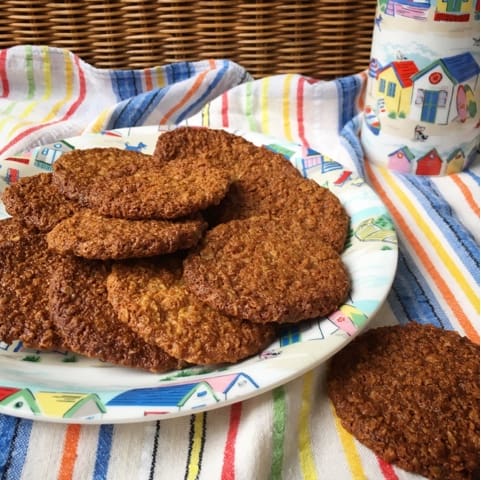Delights of New Zealand’s Biscuits: A Yummy Guide for Parents
Welcome, parents and biscuit enthusiasts! Are you seeking scrumptious treats that hail from the splendid isles of New Zealand? Well, you’re in for a treat because we’re about to embark on a delightful journey through the mouth-watering world of New Zealand biscuits! Whether you’re packing a picnic, crafting a cozy tea time, or searching for the perfect lunchbox snack, we’ve got you covered.
Understanding the Appeal of Kiwi Biscuits
New Zealanders love their biscuits, and they have a rich tradition of baking that goes back generations. Biscuits (or cookies, as they’re often called outside of New Zealand) are a staple in Kiwi pantries, with varieties ranging from decadent chocolate-filled treats to wholesome oat-filled bites. Hence, they’re perfect for little hands and grown-up palates alike. And let’s not forget that these delightful snacks can be a great source of energy and comfort, a tiny reward after a day of adventures.
What Makes New Zealand Biscuits Unique?
New Zealand biscuits have a special place in the hearts of Kiwis for their homemade taste, use of local ingredients, and inventive flavors that set them apart. Classic ingredients like Manuka honey, golden syrup, and the native Kawakawa herb contribute to the distinctive tastes that kids love and parents appreciate for their natural goodness.
Your Guide to the Best New Zealand Biscuits for Kids
As a parent, you’re always looking for snacks that are both delicious and nutritious. Here’s an insider’s look at some of the most beloved New Zealand biscuits that are bound to be a hit with your little ones:
- Anzac Biscuits: A hearty biscuit made with rolled oats, golden syrup, and coconut, Anzac biscuits are a chewy delight that holds a special place in New Zealand’s history and culture.
- Afghans: An irresistible combo of cocoa, cornflakes, and walnuts, topped off with chocolate icing and a walnut half, these biscuits are a chocolate lover’s dream.
- Hokey Pokey Biscuits: Infused with flavors of the popular hokey pokey ice cream, these crunchy cookies feature bits of honeycomb toffee that create a delightful texture.
Want to make these treats at home? Stay tuned! We’ll share some family-friendly recipes that will bring a taste of New Zealand right into your kitchen. But first, let’s ensure we keep things safe and healthy for our kiddos.
Ensuring Biscuit Safety for Your Kids
Keeping our children’s food safe is a top priority. When it comes to biscuits, we need to be mindful of potential allergens and choking hazards. Always check the labels for allergens such as nuts, dairy, and gluten. For younger children, consider the size and hardness of biscuits, and avoid those that may pose a risk of choking. If you’re unsure, it’s always a good idea to break the biscuits into smaller pieces before serving.
Where to Find New Zealand Biscuits?
If your taste buds are tingling with excitement, you might be wondering where to find these delicious Kiwi treats. Look no further than your local international aisle at the grocery store, a specialty food importer, or even online shops that stock New Zealand products. Plus, we’ll soon share how you can bake your own with some easy-to-follow recipes!
To fully appreciate New Zealand’s biscuit culture, we’ll delve into not only their rich flavors but also the stories behind them—stories that are baked into the very fabric of Kiwi society. So, grab your apron, preheat the oven, and get ready to treat your family to a delectable dash of New Zealand’s finest!
But hey, we’re just getting started! Next up, we’ll explore how you can bond with the kids over baking, the benefits of making biscuits at home, and those much-anticipated New Zealand biscuit recipes. So make sure to keep an eye on this space for more sweet surprises coming your way!

Five Things Parents Should Know When Preparing New Zealand Biscuits
- The Importance of Quality Ingredients: Just like the picturesque landscapes of New Zealand, the quality of its local ingredients is unmatched. When preparing Kiwi biscuits at home, opt for high-quality butter, fresh eggs, and local produce like Manuka honey. Organic and non-GMO products are also great choices to ensure your homemade delights are as natural as possible.
- Navigating Through Sweeteners: Many classic New Zealand biscuit recipes include traditional sweeteners like golden syrup or treacle. These give the biscuits a unique flavor and texture. If these are not readily available, you can substitute with honey or maple syrup, though the flavor profile may differ slightly.
- Understanding Nutritional Balance: While indulging in biscuits is a treat, maintaining balance is key. You can tweak recipes for a healthier twist, such as using wholemeal flour instead of white, reducing sugar, or adding seeds and nuts for additional nutritional benefits. Nonetheless, always be aware of any potential allergies your child might have.
- Bonding Over Biscuit Baking: Baking biscuits is not just about the end product; it’s a wonderful way to spend quality time with your children. Involve them in the process, from measuring and mixing to shaping the dough. This is a fun way to teach them about cooking and the joys of creating something with their own hands.
- Storing Your Biscuits: Proper storage can keep your biscuits delicious for days. Once cooled, store them in airtight containers to maintain their texture and taste. If you’ve made a large batch, consider freezing some biscuits, which can be a perfect grab-and-go treat when you need it.
Family Bonding with Homemade Biscuit Recipes
One of the many joys of New Zealand biscuit making is the endless opportunities it provides for family bonding. Baking with your kids can help instill a love of cooking, develop their fine motor skills, and create lasting memories. Plus, by baking at home, you can control what ingredients go into your biscuits, ensuring they’re as wholesome as they are tasty.
Benefits of Making Biscuits at Home
Making biscuits at home has plenty of benefits, aside from the delicious outcome. It’s cost-effective, can become an educational activity, and you can tweak traditional recipes to suit dietary requirements. Homemade biscuits typically contain no preservatives or artificial flavors, making them a healthier choice for snack time. Additionally, baking from scratch means less packaging waste, promoting a small step toward sustainability in your household.
Easy New Zealand Biscuit Recipes for Parents
Ready to don your baking hat and whip up some Kiwi-inspired treats? Perfect! Here are some quick, easy, and parent-approved New Zealand biscuit recipes that are bound to bring smiles and satisfaction to both you and your kids:
- Classic Anzac Biscuits: Celebrate a slice of history with these sweet, oat-laden biscuits. They’re delightfully crisp on the outside and chewy in the center.
- Chocolate-Dipped Hokey Pokey Biscuits: Combine the fun of honeycomb toffee with a chocolatey twist in this kid-favorite that’s sure to inspire a happy dance.
- Homestyle Afghan Biscuits: Dive into a rich, cocoa-flavored treat, adorned with a generous dollop of chocolate icing. A walnut or a sprinkle of coconut can add the perfect finishing touch.
All of these recipes are simple enough to involve the children, and the results? Absolutely delicious! As a sweet bonus, these biscuits are perfect for sharing, nurturing your kids’ sense of generosity and community. Whether enjoyed with friends at school, offered at a family gathering, or savored during a quiet moment at home, New Zealand biscuits are more than just snacks—they’re a reason to come together and celebrate the small joys in life.
So gather your ingredients, round up the little ones, and let the blissful aroma of baking biscuits fill your home. Each recipe invites you to put your own spin on it, making every batch uniquely yours. And who knows? You may just start your own family tradition that your kids will one day share with their own. Happy baking!
See more great Things to Do with Kids in New Zealand here. For more information see here
Disclaimer
The articles available via our website provide general information only and we strongly urge readers to exercise caution and conduct their own thorough research and fact-checking. The information presented should not be taken as absolute truth, and, to the maximum extent permitted by law, we will not be held liable for any inaccuracies or errors in the content. It is essential for individuals to independently verify and validate the information before making any decisions or taking any actions based on the articles.




